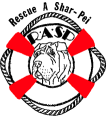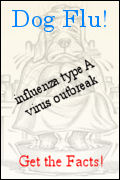|
|
Past Newsletters

The CSPCA Charitable Trust needs your support through donations to continue vital research projects. Your donation is tax deductible.

RASP (Rescue A Shar-Pei) is a volunteer group with a concern for abandoned and abused Shar-Pei in Illinois / Indiana / Wisconsin and surrounding areas.
|


|

|
|

Volume 7, Issue 1
March 2003
Miscellaneous Gastrointestinal Conditions
Gastroenteritis
“Gastroenteritis” specifically refers to inflammation of the stomach, small
intestine and large intestine without diagnosis of the cause. Most often this
condition is caused by changes in diet whether intentional or unintentional,
bacterial disease, viral disease, parasites, medical diseases such as inflammatory
bowel disease or other conditions, toxicities, etc. The most common cause is
changes in the diet and is usually seen as colitis which typically has clinical
signs such as loose, cow-pie stools, mucous (“slimy stools”), straining to have
bowel movements with little or no stool (tenesmus), blood in the stool (hematochezia),
having frequent, small stools and house-broken dogs which have bowel movements
in the house due to a sense of urgency. In the vast majority of cases the dogs
are not systemically ill – they continue normal activities, eat well, and look
good. These signs are due to inflammation of the large intestine or colon. By
changes in diet I am referring to changes in brands, formulation, amount fed,
frequency, dogs that eat raw hide chews, pig’s ears, garbage, plant material,
and foreign objects. Many times colitis can be handled by withdrawing solid
food for 24-48 hours only giving small amounts of liquids often. I often continue
feeding through colitis but add a fiber supplement such as Colon-PureTM obtainable
from General Nutrition Centers. For the average size Shar-Pei I add about ½-1 tblsp
per meal. It is a powder and I mix it with a little bit of water and the resultant
gel is added to the food. If I don’t see a response within 24-48 hours then medical
treatment may be necessary especially if the dog is systemically ill. Another
common but often over-looked cause of colitis is emotional or stress-induced colitis.
This often happens in house dogs that are boarded during the owner’s vacation.
Other changes in routine can also cause colitis – changes in work schedules, new
people (workmen) in the house, visitors, new animals, training classes, etc.
These cases also often respond to fiber supplementation but additional measures
may need to be taken. These may include the use of a pet sitter, dog walker,
doggy daycare, behavior modification techniques and even drug therapies such as
anxiolytics, tricyclic antidepressants and other drugs.
Another manifestation of gastroenteritis may be vomiting. Pretty much the same
causes of colitis can result in vomiting. The recommendation of liquids only
still goes – usually small amounts often. Occasionally anti-vomiting medication
and fluid therapy are necessary if the vomiting doesn’t respond to conservative
measures. Dehydration is always a major concern.
Lastly gastroenteritis can show up as a small intestinal diarrhea with very
watery stool as the major clinical sign. Again conservative therapy is tried
for 24 hours but medical therapy is often necessary. Dehydration can occur very
easily especially if vomiting accompanies the diarrhea. As long as the dog is
not systemically ill conservative therapy can be tried for 24-48 hours.
Certainly if there is no response to conservative therapy then a work up is indicated
including a complete blood count, blood chemistry screen, abdominal radiographs,
stool examination both floatation and direct and a urinalysis.
Gastroesophageal Reflux
Gastroesophageal reflux is similar to GERD (gastroesphogeal reflux disease) in
humans and usually results in the vomiting of a small amount of yellow to green
fluid early in the morning before the dog has breakfast. This fluid usually consists
of stomach acid. Dogs do not continuously secrete stomach acid as humans do but
tend to produce acid in anticipation of a meal. If there is no food in the stomach
at the time the acid is present then irritation can result and vomiting can result.
This can often be handled by giving a little bit of food or several dog treats at bedtime
or early in the morning before feeding the dog. If it persists I often try Tagamet HB®
to decrease stomach acid formation for several days. Rarely this condition can
result in esophagitis or erosions in the esophagus. This condition is painful
and loss of appetite, trouble swallowing, regurgitation and dehydration can result.
Coprophagy (Stool eating)
Most dogs that eat stool do not have a dietary deficiency and there is not a
gastrointestinal basis for this behavior. At some level coprophagy involves
play, sampling and learning. It is a normal behavior for a mother with young
pups to exhibit and probably developed as a behavior to keep the den area clean
and disease-free as well as preventing predators from finding the den area. In
my experience the behavior occurs much more often in female dogs and is usually
directed toward eating the stool of other dogs. The easiest way to avoid the
development of this behavior is to keep the yard free of feces and supervise and
correct dogs when they are in the yard or on leash walks. Some limited success in
stopping this behavior can occur by making the stool distasteful to ingest. This
can be done using monosodium glutamate (Adolf’s Meat Tenderizer® or similar
product) at ½-1 tsp. per meal to the dogs producing the stool the
coprophagic dog is eating. The earlier the behavior is caught and dealt
with the better although the secret is not to let this habit develop in the first place.
The Formation of the Chinese Shar-Pei Club of America, Inc. (cspca)

Shortly after these early importations, Shar-Pei fanciers in the United States recognized the need to organize and publicize the breed. This was necessary for the following reasons:
- It became necessary for breeders to know what breeding animals were available and who owned them. This facilitated correcting breeding problems and adding new breeding stock to the genetic pool as new individuals were imported into the United States.
- It facilitated the sale of puppies from these planned breedings.
- It helped in the dissemination of information to the public concerning Shar-Pei.
- This was a necessary step in the process to achieve recognition by the AKC.
The exchange of information between the members enhanced knowledge concerning the breed’s health problems, breeding problems, etc.
The following is a brief synopsis of the first 7 meetings of the Chinese Shar-Pei Club of America, Inc. These are included for several reasons:
- It gives the content of the meetings and what the members considered important activities, etc.
- It gives some personal insight into the “founding fathers” of the breed in the United States.
- It gives us a glimpse into the early activities of the club.
- Here we can see the roots of our standard, registry, etc.
We get an idea of the early conflicts, struggles i.e. “growing pains” of our breed.
The first organizational meeting of the CSPCA was held April 26, 1974 at the home of Mr. and Mrs. Carl Sanders of Ashland, Oregon. By this time there were 13 known owners of Shar-Pei with a total of 27 dogs.
At this meeting the decision was reached to change the name of the breed from the Chinese Fighting Dog to the Chinese Shar-Pei, which was necessary due to the negative publicity concerning dog fighting in this country. The name of the club was decided upon as well. One of the main topics of discussion concerned the differences in type seen in the various Shar-Pei. These differences were especially prevalent in the dogs being imported from Matgo Law and probably were the result of crossbreeding as previously discussed. It was decided to obtain the original Hong Kong Kennel Club standard and any additional information about the breed from China. A suggestion was also made about drafting a new standard attempting to include features of all the present types. Officers were elected with Carl Sanders as President, Lois Alexander as Secretary, John Purcell as Treasurer, Ernest Albright as Historian and Dee-Jon Seas as the Registrar. Mrs. Seas was delegated to set up and maintain the Stud Book for registration of all known purebred Chinese Shar-Pei in the United States.
The second meeting of the club was held July 27, 1974 in Talent, Oregon at the home of Lois and Norm Alexander. Rene Lew was appointed official club representative to the AKC. She was to present an annual report to the AKC in April 1975 which was to include all membership and treasury reports, photos, material from the club publication The Barker, a copy of the Standard and other pertinent information. Correspondence from the Hong Kong Kennel Club indicated that in the past, registration of the Shar-Pei had been denied for several reasons. Both Ernest Albright and Rene Lew reported on dog shows and obedience matches they had participated in. Sue Weaver was elected to publish a breed brochure containing basic information about the breed. Lois Alexander had already started a membership file. Dee-Seas was asked to start the CSPCA Official Dog Registry. Jean Fein was asked to author the official Code of Ethics. Nadine Purcell volunteered to keep litter records and the suggestion was made that the CSPCA join the National Association of Rare Breed Dog Owners. The known Shar-Pei population in the U.S. as of August 1974 was 28 dogs.
The third organizational meeting of the CSPCA was held at the home of Ernest and Madeline Albright in Pleasant Hill, California on November 3, 1974. The members present voted to join the National Rare Breed Club. Showing Shar-Pei in conformation was discussed and it was decided the breed should be considered for the Non-Sporting Group. Lois Alexander recommended adoption of Conformation Championship rules and a schedule of points similar to those used by the Pharoh Hound Club of America. It was suggested by the members present “an entry of four or more Chinese Shar-Pei owned by three or more owners and judged by a Miscellaneous Group judge would constitute a Shar-Pei Specialty Match”. The first Barker was published in April 1975.
The fourth organizational meeting of the national club was again held at the Albright’s home in Pleasantville. Walter DeLear moved that the breed become officially known as the “Chinese Shar-Pei”. This proposal was seconded and passed. The breed standard was discussed. A 32 statement “Official Standard of the Chinese Shar-Pei in America” was composed to be sent to all known owners of Shar-Pei – about 30 at this time. Charter membership was also discussed. As of April 1976 there were 19 CSPCA members. Current and future prices for Shar-Pei puppies were discussed with most members favoring $500 as a minimum price for good puppies. Cost of stud service was placed at $200 with a puppy back. Dugan Skinner announced the results of a survey he had conducted on Shar-Pei in America. As of January 1976 there were 27 Shar-Pei owners with a total of 56 dogs – 25 males and 31 females. The first pedigree certificate (CSPCA – 1) was issued November 9, 1976 to Down-Homes China Souel owned by Ernest Albright.
The fifth organizational meeting was held April 23, 1977 at the Albright home. Members agreed to send in pedigrees of their dogs with their membership applications for 1977. Everyone who does this will be sent a copy of the other members’ pedigrees. Also included will be a questionnaire concerning specifics about each dog such as tail length, tongue color, coat type, etc. Members also decided they would like to see a
quarterly newsletter come out. New officers were elected.
The sixth meeting of the CSPCA took place in Hinckley, IL June 17, 1978. This meeting was held in conjunction with the first annual Chinese Shar-Pei National Specialty show at Pioneer Park, which was sponsored by the CSPCA. Unfortunately, both the show and the meeting were later declared “unofficial” due to an oversight, which resulted in official announcements of the meeting not
being sent to all club members. The show was still a major success in the American history of the breed with 46 Shar-Pei entered which represented 1/3 of the dogs in the United States at that time. The judge, Mr. Harvey Berman, chose Walnut Lane’s China Foo owned by Dee and Victor Seas as the Best of Breed. At this “non-meeting” the method of electing new officers was discussed as well as the election of a Board of Directors. Mr. Albright was selected as a lifetime Board member. An official Constitution and By-Laws in accordance with AKC guidelines was to be developed by Mrs. V. Fahse.
Shortly following the ill-fated sixth annual meeting and first annual specialty. A division occurred among the members of the club. It appears that bad feelings concerning the lack of notification about the meeting in Hinckley as well as disputes about the stud book and financial aspects of the club fueled a split with factions headed by Ernest Albright on one side and Ted Linn on the other. Two new clubs were the result. The Chinese Shar-Pei Club of America, Inc. continued under the leadership of Ernest Albright. At this time the club became known as the Original Chinese Shar-Pei Club of America, Inc. (West Coast). The new club registrar at this time became William W. Morrison. The Chinese Shar-Pei Club of America, Inc. (East Coast) under the leadership of Ted Linn was incorporated in the state of Delaware December 6, 1978. The first meeting of the CSPCA, Inc. was held February 10 and 11, 1979 at the Airport Ramada Inn, in Atlanta, Georgia. At this time there were 83 charter members. This club formulated a new constitution and by-laws, a new breed standard and a new breed registry. At this time there existed three groups of club members: members of the Original CSPCA (West Coast), members of the CSPCA (East Coast) and members holding dual membership in both clubs. Finally in July 1981 the differences between the two clubs were resolved and the registries were combined under the CSPCA, Inc. Due to the two years that two clubs existed, many dogs had registration in both club’s registries. In the first Stud Book published in June 1982 many registry files were closed and some files were cancelled in an effort to eliminate the duplicate registration of a dog.
The seventh meeting of the Original CSPCA took place in San Juan Capistrano, California on June 30, 1979 and was hosted by the Southern California Chinese Shar-Pei Club. This club was the first local club to become affiliated with the national club and was formed in February 1979. At the June meeting plans were formulated to host the National Shar-Pei Specialty Show to be held July 1, 1979 at San Juan Capistrano. It was decided to invite Matgo Law to judge the show. This show was actually the Second Annual National Shar-Pei Specialty. The Best of Breed at this show was Eshaf’s Hoi-Ti owned by Emil and Vern Fahse.
Since 1981 the CSPCA continued to grow and develop at a phenomenal rate. By 1991 there were well over 10,000 members with over 50,000 registered Shar-Pei. In July 1985 the Chinese Shar-Pei breed was recognized by the United Kennel Club. This was followed in May 1988 by AKC recognition and placement into the Miscellaneous Class. In August of 1992 the final goal was reached when the Chinese Shar-Pei was placed into the Non-Sporting Group of the American Kennel Club and became the 134th breed recognized by that club. The road from almost extinction to AKC recognition has been a long and perilous one. Much work remains — health issues need to be addressed, educating new members must be a priority, breed rescue issues are becoming paramount and the CSPCA’s own future needs to be mapped out. The next decade will be exciting, critical and extraordinary for our breed.
|
|

